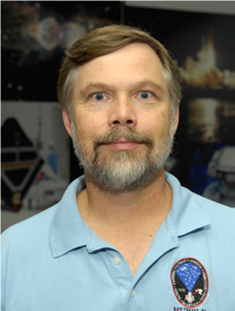Abstract:
A Comparison of Human and Robotic Servicing of the Hubble Space Telescope
The fourth servicing mission of the Hubble Space Telescope (SM4) may be unique in the history of spaceflight by having been thoroughly worked for both human and robotic implementations and then executed by one. This talk will compare these two approaches to this mission and explore the advantages and disadvantages of both.
SM4 was originally planned to fly on the Space Shuttle in February 2004 as the last HST servicing mission. SM4 was cancelled in January 2004 following the Columbia accident. In March 2004, the HST Program was asked to embark on an effort to examine the feasibility of extending the useful scientific life of the HST observatory through robotic servicing. The result was the Hubble Robotic Servicing and De-orbit Mission (HRSDM) that was pursued through a very successful Preliminary Design Review in March 2005. In April 2005, the possibility of a Shuttle-based SM4 was raised again as a part of the Return to Flight assessments and this resulted in the October 2005 decision to add SM4 back to the Shuttle manifest. The penultimate launch date for SM4 was October 10, 2008. This was delayed to May 12, 2009 when it was decided to add the HST Science Instrument Command and Data Handling (SI C&DH) subsystem replacement to the SM4 manifest following a failure of the primary side of the on-orbit unit on September 28, 2009.
STS-125 finally launched on May 11, 2009 and the seven person crew exceeded every measure of mission success during five spacewalks. Atlantis safely returned to Edwards Air Force Base on May 24, 2009. The post-SM4 Servicing Mission Orbital Verification subsequently demonstrated that all mission elements met or exceeded their respective performance requirements on-orbit. SM4 left HST with six working, complementary science instruments for the first time since 1993 and the replacement of the gyros, batteries, and Fine Guidance Sensor, and the upgrade of the outer blankets have extended the expected lifetime of the observatory by at least five years.
Biography:
 Art Whipple
is the Lead Mission Systems Engineer for the Hubble Space Telescope (HST) Program at NASA’s Goddard Space Flight Center. He has worked on Hubble in various capacities from Astrometry Science Team member to Systems Manager since 1982. Art has a B.A. in mathematics from The University of Rochester, and a M.A. in mathematics and a Ph.D. in aerospace engineering from The University of Texas, Austin.
Art Whipple
is the Lead Mission Systems Engineer for the Hubble Space Telescope (HST) Program at NASA’s Goddard Space Flight Center. He has worked on Hubble in various capacities from Astrometry Science Team member to Systems Manager since 1982. Art has a B.A. in mathematics from The University of Rochester, and a M.A. in mathematics and a Ph.D. in aerospace engineering from The University of Texas, Austin.
 Art Whipple
is the Lead Mission Systems Engineer for the Hubble Space Telescope (HST) Program at NASA’s Goddard Space Flight Center. He has worked on Hubble in various capacities from Astrometry Science Team member to Systems Manager since 1982. Art has a B.A. in mathematics from The University of Rochester, and a M.A. in mathematics and a Ph.D. in aerospace engineering from The University of Texas, Austin.
Art Whipple
is the Lead Mission Systems Engineer for the Hubble Space Telescope (HST) Program at NASA’s Goddard Space Flight Center. He has worked on Hubble in various capacities from Astrometry Science Team member to Systems Manager since 1982. Art has a B.A. in mathematics from The University of Rochester, and a M.A. in mathematics and a Ph.D. in aerospace engineering from The University of Texas, Austin.